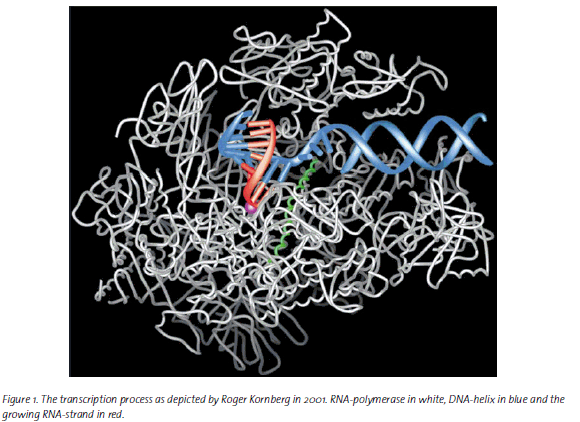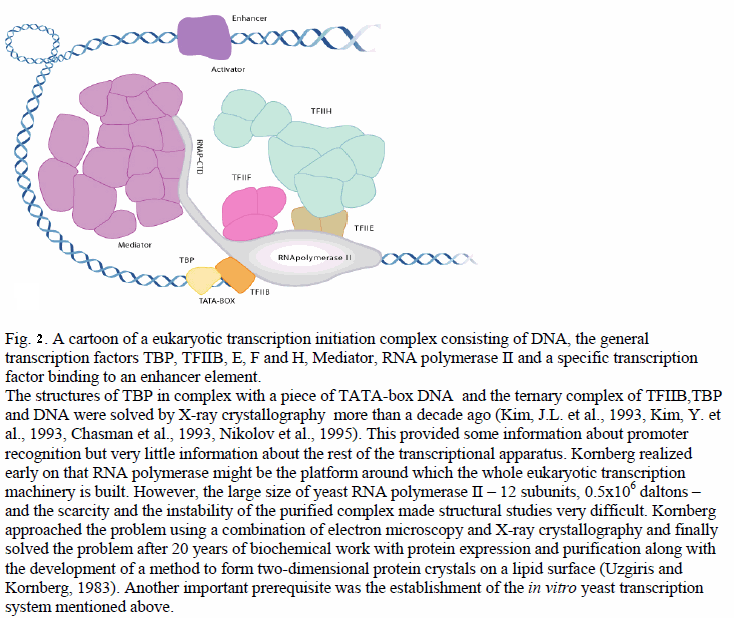|
|
|
|
|
|
|
News & Views item - October 2006 |
![]() For Studies of the Molecular Basis of Eukaryotic Transcription of DNA to RNA
Roger Kornberg is the 2006 Nobel Laureate in Chemistry. (October 5, 2006)
For Studies of the Molecular Basis of Eukaryotic Transcription of DNA to RNA
Roger Kornberg is the 2006 Nobel Laureate in Chemistry. (October 5, 2006)
|
|
|
Professor Roger Kornberg |
The Royal Swedish Academy of Sciences today announced the winner of this year's Nobel Prize in Chemistry -- Stanford University's Roger Kornberg "for his fundamental studies concerning how the information stored in the genes is copied, and then transferred to those parts of the cells that produce proteins. Kornberg was the first to create an actual picture of this process at the molecular level, in the important group of organisms called eukaryotes (which, as opposed to bacteria, have well-defined cell nuclei). Mammals like ourselves, as well as ordinary yeast, belong to this group of organisms."
A nine minute interview with with Professor Kornberg by Adam Smith, Editor-in-Chief of Nobelprize.org which took place immediately after the announcement of the award is available online in both listenable and readable versions.
In 2001, Kornberg with his collaborators solved the structure of RNA polymerase II — an enzyme that helps messenger RNA take information from DNA. By analysing crystals of the polymerase, using X-ray crystallography, he was able to painstakingly determine their structure. But it was 25 years of lead up work unraveling the system that came before that event.
"This is the largest protein-only structure ever solved," says Jesper Svejstrup, a gene-transcription researcher at Cancer Research UK, who was a postdoctoral student with Kornberg from 1993 to 1996.

Steve Jackson, a transcription expert from Cambridge University, UK, says, "The approach he's taken combines biochemistry, structural biology and molecular genetics with functional studies."
While the relatively simple system for the transcription of DNA to proteins via RNA had been elucidated in bacteria by the mid-1960s, that in organisms containing nuclei (the eukaryotes) proved to be much more complex.
In the late 1980s, Kornberg's lab purified an eukaryotic transcription complex from yeast that included RNA polymerase II (pol II) and five associated proteins called general transcription factors; surprisingly, this complex didn't respond to other proteins known to activate specific genes. Professor Kornberg's tenacity led his group to another key molecular player known as "mediator"-- a complex of some 20 proteins that helps bridge the work of pol II with proteins that turn on specific genes.

A write-up of the work is available at http://nobelprize.org/nobel_prizes/chemistry/laureates/2006/chemadv06.pdf
Professor Kornberg's father, Arthur (now professor emeritus at Stanford), shared the 1959 physiology or medicine Nobel Prize with Severo Ochoa for their discovery of the mechanisms in the biological synthesis of RNA (ribonucleic acid) and DNA (deoxiribonucleic acid).